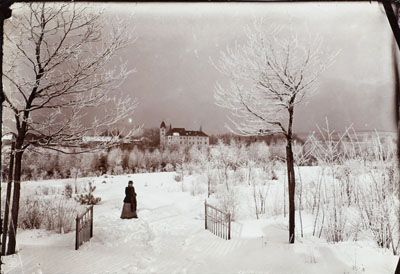
Landscape - Image- Photography
Karel Maria Chotek » František Drtikol » Jindrich Eckert » Jaroslav Feyfar » & others
Exhibition: 22 Apr – 4 Jul 2010
Galerie Rudolfinum
Alsovo nabrezi 12
110 00 Praha
+420 22-7059205
galerie@rudolfinum.org
www.galerierudolfinum.cz
Tue-Sun 10-18
Landscape / Image / Photography April 22 - July 4, 2010 curator: Mrs. Lucie Vlckova small gallery Confrontation of the representative works of the pivotal authors of Czech landscape photography and landscape painting from the 19th century and the beginning of the 20th century. The majority of the works are from the Museum of Decorative Arts collection. Landscape photography emerged as a specific genre shortly after photography was invented and began to be used in a practical way. Yet this had not been a matter of course: the perception of the natural environment as subject matter worthy of depiction, not to mention the appreciation of its aesthetic qualities, required a highly complex and by no means effortless transformation of the intellectual approach to nature. This shift took place in Western Europe, particularly England and Germany, from the 1780s onward and was accompanied by an intensive development of the natural sciences, as well as an increasing interest in landscape painting. However, it was a long time before landscape painting came to be viewed as an autonomous genre in its own right and before the field acquired a more favourable position in the traditional hierarchy of art styles as well as the stable backing of the academic milieu. When photograhy entered the scene in the 1840s, it was no longer doubted that landscape representation would be a central theme in visual and other arts for a long time to come, and that landscape painting would be a dominant branch of painting throughout the rest of the century. However, few people in those days could anticipate how great its role would ultimately be in the emergence of modern art in the late 19th century. For that matter, hardly anyone could divine the crucial impact photography would have on the pictorial perception of the world. During the second half of the 19th century, landscape painting and photography acquired increasing artistic and social importance. While many a time their methods and goals clashed, the two fields also enriched each other. In view of the fact that the two art media occupied a prominent place in the visual arts of those days, it is most interesting to follow their mutual confrontations and the interactions of their creative methods and means of expression. This exploration can help to shed light on many now-forgotten circumstances, which in turn may enhance the established interpretation of landscape painting and landscape photography. The exhibition is divided into three independent sections. Its concept has been devised to examine the basic approaches to landscape representation as they were gradually constituted in the field of landscape painting. Attention will be also devoted to the relevant subject matter and structural framework which landscape photography adopted from landscape painting, almost as a matter of course. The first section deals with an approach characterized by an interest in capturing the visual aspects of the surrounding environment, based on the artist's individual experience with the specific setting and his endeavour to depict the scene in a descriptive and objective manner. The clash between individual experience and objectiveness, which was anchored in landscape representation during the Biedermeier era, not only determined landscape photography during its early stage, but more or less continuously. The exhibition's second section examines another strongly represented trend in Bohemia, which was distinguished by a penchant for monumentality that translated the initially romantic conception into a personally detached statement, giving rise to many pictorial clichés. Photography paraphrased these stereotypes in a distinctive fashion, whether these were pictures of the Bohemian lands' mythical topography, or of other themes popular in landscape painting. The third section explores the pictorial treatment of scenery that both art forms arrived at almost simultaneously in the 1890s, one marked by a radical abandonment of preconceived stereotypes in landscape representation. Quite often, though, accentuating the artist's subjective experience and the discovery of landscape's structural properties and symbolic meanings only seemingly led to freedom of artistic expression. The exhibition offers a representative selection of Czech landscape photography ranging from the mid-19th century to the first decade of the 20th century, from the collections of the Museum of Decorative Arts in Prague. The photographic images are complemented by superb paintings and prints housed in the National Gallery in Prague, the National Technical Museum and the Regional Museum in Teplice. Among the photographers represented in the display are Jindřich Eckert, František Drtikol, Jaroslav Feyfar and Karel Maria Chotek; the painters include Antonín Mánes, Julius Mařák and Jakub Schikaneder, among others.